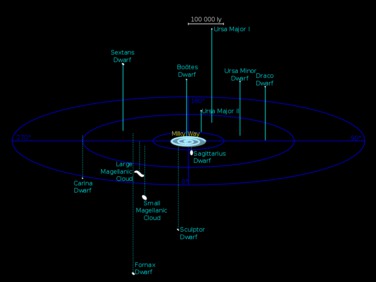The Milky Way galaxy is massive enough to have collected a system of irregular dwarf galaxies around it. Most of these galaxies contain tens of millions of stars, a far cry from the 200 to 400 billion stars that make up the Milky Way.
These dwarf galaxies are gravitationally bound to the Milky Way in orbits that can take several billion years to complete. The most famous of these companions are the Large and Small Magellanic Clouds, each of which lies about 200,000 light-years away; they were first observed even before the invention of the telescope. Only the tiny Sagittarius dwarf elliptical galaxy and the newly discovered Canis Major dwarf galaxy are closer to Earth than this pair.
The irregular shape of these galaxies is a result of their proximity to the massive Milky Way, whose gravity pulls the smaller galaxies in and distorts their shape.
Other dwarf galaxies in the vicinity of the Milky Way include Ursa Major, Carina, Draco, Sculptor Dwarf, Sextans Dwarf, Fornax, Leo I, Leo II, and possibly Phoenix and Leo A.
The Andromeda and Triangulum galaxies each have a similar system of dwarf galaxies. And many other irregular dwarf galaxies float alone within the gravitational field of the Local Group.
